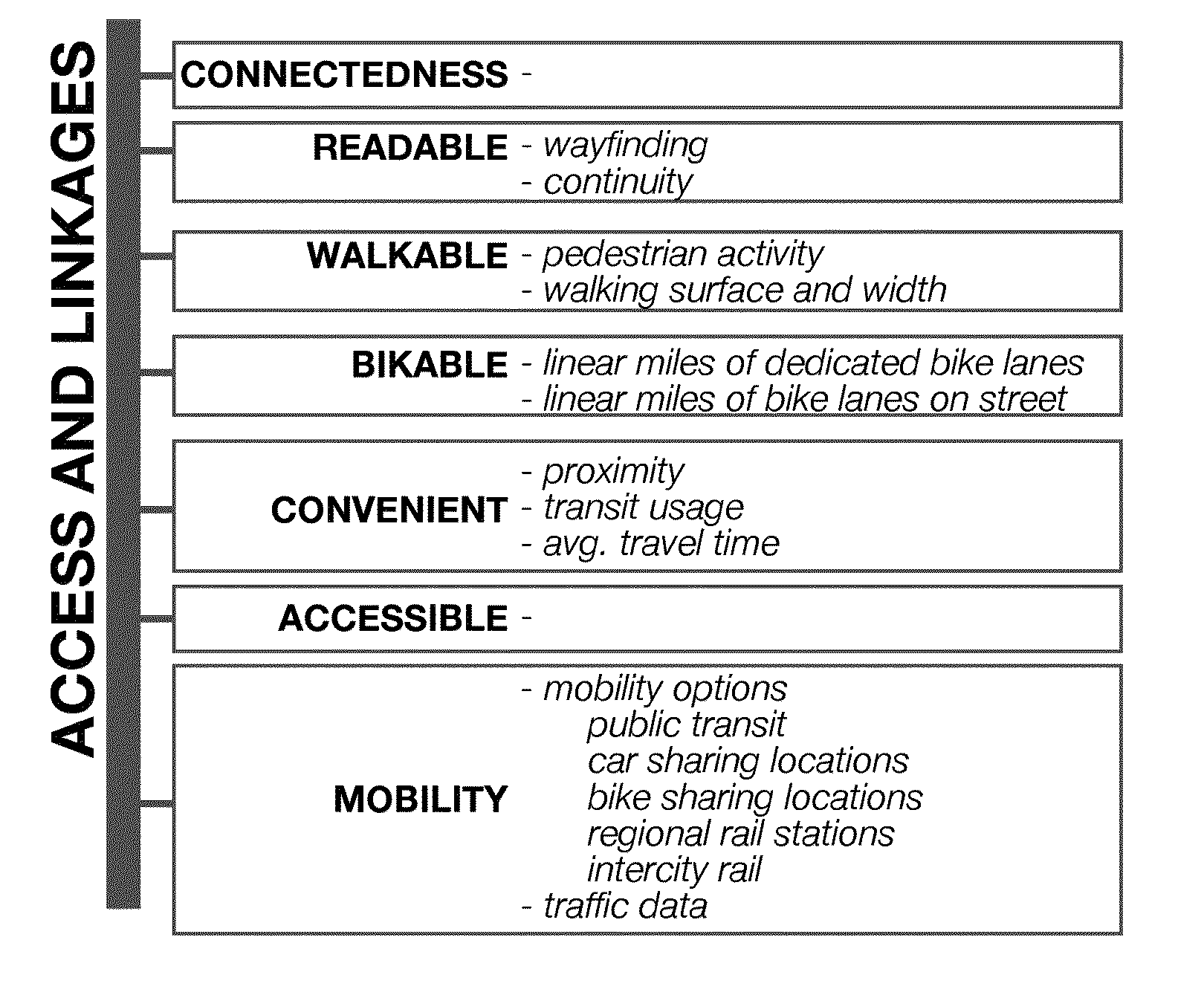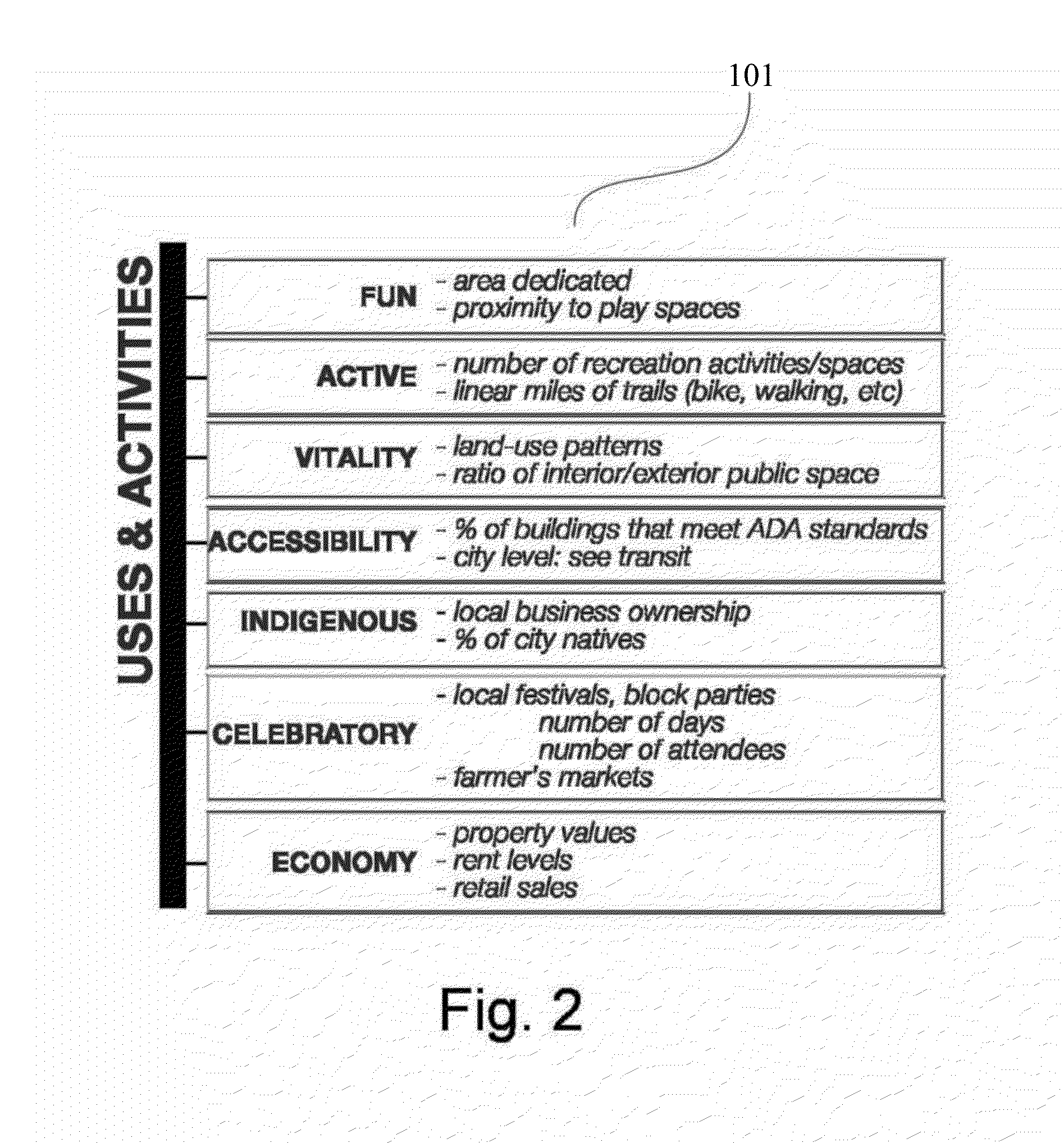Data Driven Placemaking
- Summary
- Abstract
- Description
- Claims
- Application Information
AI Technical Summary
Benefits of technology
Problems solved by technology
Method used
Image
Examples
example 1
Walkability
[0184]Walkability is a category that considers one's commute; model variables include amenities in walking distance and the quality for the experience of the pedestrian. Advantageously DDP analyzes the walkability of both proposed design model neighborhoods and built. The process of determining walkability as in FIG. 7 first uses located data sources for model variables that is referenced when computing the score and ratings, such as Google, Localeze, Open Street Map, education.com and schedules from transit agencies. Furthermore, information on grocery, restaurants, shopping, coffee, banks, parks, schools, books, entertainment, intersection density and average block length may be used as model design variables.
[0185]Furthermore, model variable data may include spatial and cultural data used to analyze proposed plans include GIS data from states, cities and nations. As well as census, cultural and economic data, LiDAR and Landsat imaging, as well as agencies such as the U...
example 2
Non-Successful DDP Design Precedent Hartford, Conn.
[0186]It is another feature of the invention for DDP to compare designs that are successful in comparable existing conditions as well as designs that are non-successful.
[0187]City: Hartford, Conn.
[0188]Neighborhood: Downtown Hartford
[0189]City Data:
[0190]Ranking: Undefined
[0191]Land Area: 17.3 square miles
[0192]Population: 124,060 in 2000
[0193]Economy: Medium income $28,300;
[0194]⅓ of population poverty stricken
[0195]Universities: Over 6,000 students
[0196]Key problems / struggle: Crime / poverty
[0197]Connections: Major airport for international flights; highways
[0198]Climate: Coastal+Northern
[0199]Overview: Hartford was considered one of the greatest cities in the United States up until the introduction of the automobile. When interstates 84 and 91 were created, both bordering downtown Hartford, the city floundered.
Evidence of Non-Success in the Neighborhood:
[0200]Low percentage of population taking public transportation[0201]High crime...
example 3
Non-Successful DDP Design Precedent Cambridge, Mass.
[0206]It is another feature of the invention for DDP to compare designs that are successful in comparable existing conditions as well as designs that are non-successful.
[0207]City: Cambridge, Mass.
[0208]Neighborhood: Kendall Square
[0209]Ranking: Undefined
[0210]Land Area: 1.241 square miles
[0211]Population: 12,940
[0212]Economy: MIT owns a lot of commercial real estate; business in neighborhood is technology driven
[0213]Universities: MIT nearby
[0214]Connections: Bus Routes and MBTA Red Line
[0215]Climate: Coastal+Northern
[0216]Overview: In the 1990s and 2000s, the area between Kendall and Cambridge Side Galleria transformed into what it is today. The square currently holds many offices, research buildings, biotechnology firms, and information technology firms. As a result, the square is only occupied during office hours.
Evidence of Non-Success in the Neighborhood:
[0217]Low green space and land percentage.[0218]Low diversity in buildin...
PUM
 Login to View More
Login to View More Abstract
Description
Claims
Application Information
 Login to View More
Login to View More - R&D
- Intellectual Property
- Life Sciences
- Materials
- Tech Scout
- Unparalleled Data Quality
- Higher Quality Content
- 60% Fewer Hallucinations
Browse by: Latest US Patents, China's latest patents, Technical Efficacy Thesaurus, Application Domain, Technology Topic, Popular Technical Reports.
© 2025 PatSnap. All rights reserved.Legal|Privacy policy|Modern Slavery Act Transparency Statement|Sitemap|About US| Contact US: help@patsnap.com



